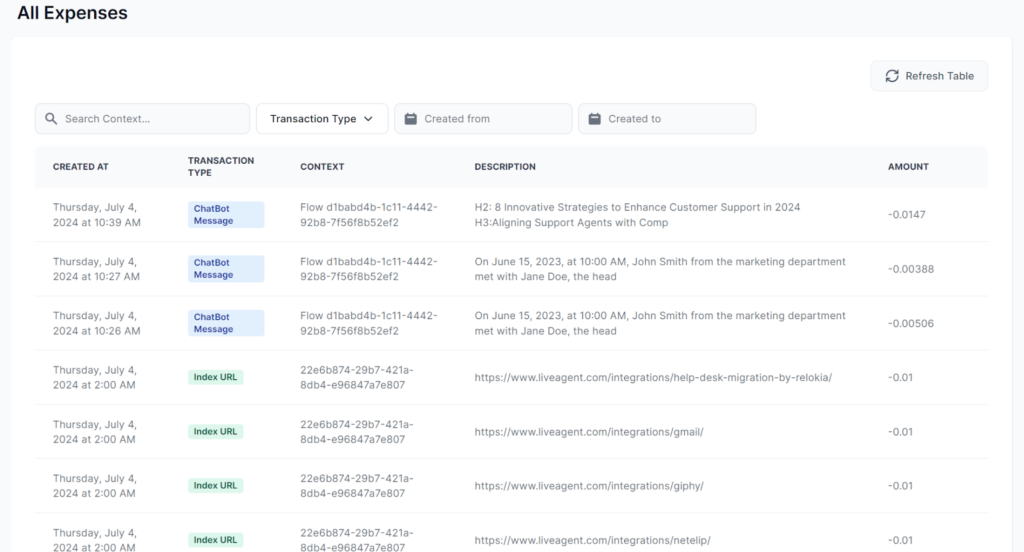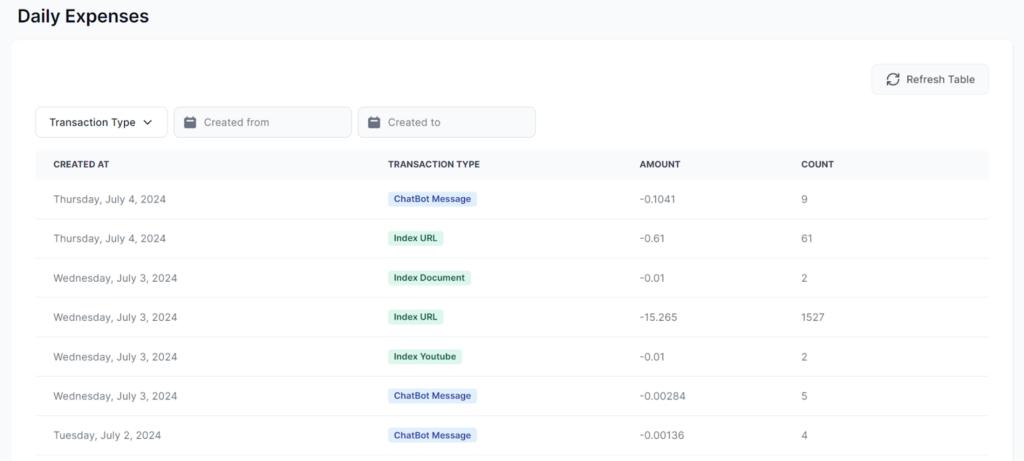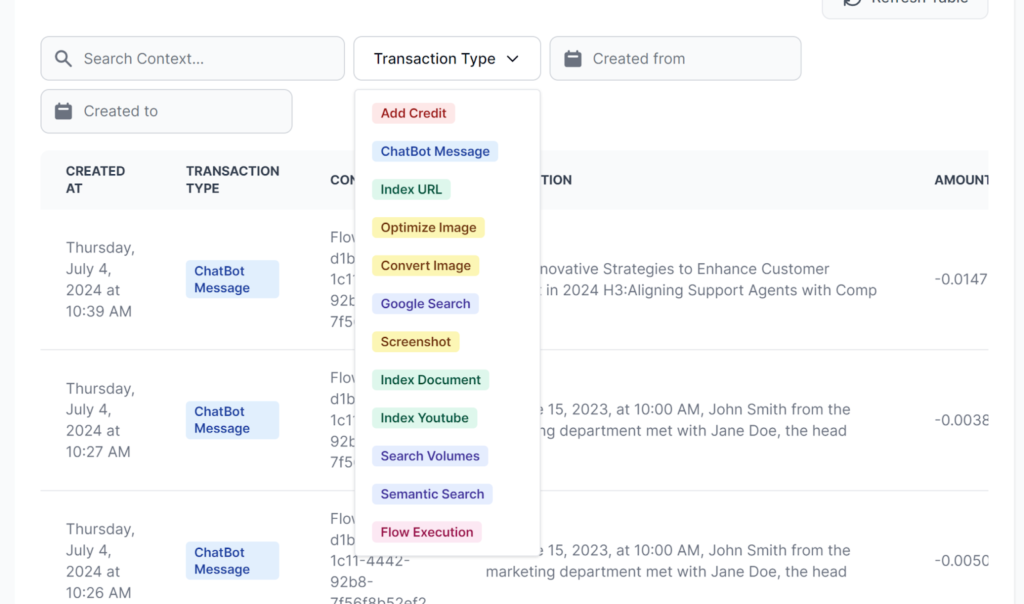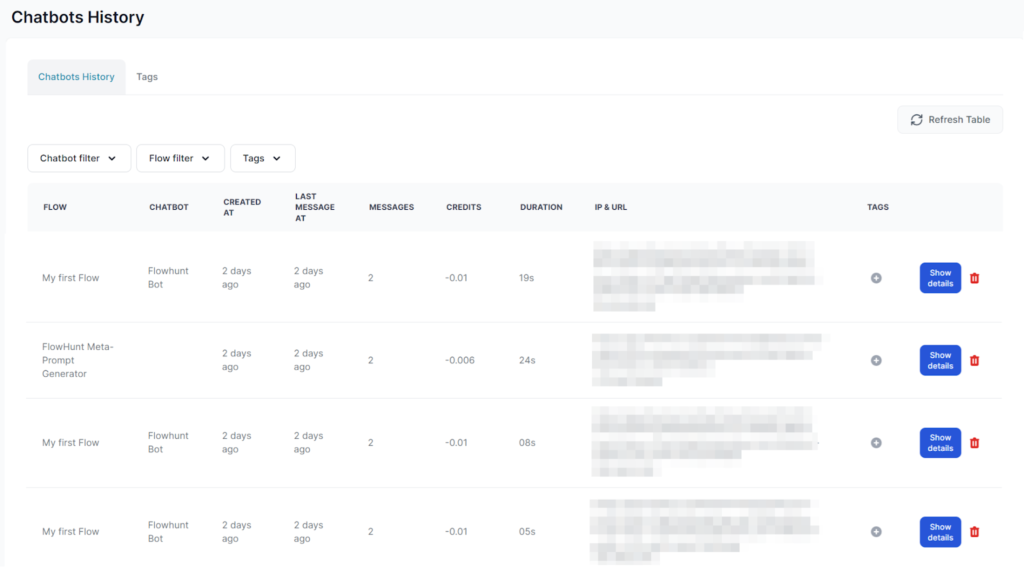
All Expenses
The All Expenses screen gives you insights about each individual transaction, allowing you to understand, track, and improve your AI usage. It’s a detailed rece...

Track and manage your spending patterns with FlowHunt’s Daily Expenses feature, summarizing transactions by type and date for effective budget oversight.
The Daily Expenses provides a summarized view of your usage, grouping the transactions by type and date. This allows you to easily track spending patterns and resource allocation, making it easier to manage your budget effectively.
If you want to see each expense individually, go to the All Expenses screen.
This view groups the expenses by transaction type for any given date. This means you may see several entries from a single date, but each one will focus on a specific type of transaction.
As you can see below, we only Indexed URLs and chatted with the bot on July 4th, but we also indexed documents and YouTube videos on the 3rd:
The view further shows the overall amount spent on all transactions of the type that day and the number of transactions performed. For example, on July 3rd, we crawled a whopping 1527 URLs, costing over $15.
You can set a date range or pick the transaction type to filter the expenses. The transaction types are based on the various tasks the Flows can perform:
To better understand the pricing of individual interactions, you should first understand the pricing of AI models and how they translate into FlowHunt Credits.
AI uses Tokens to process the language. It’s hard to precisely translate a token, as it might be one word, only a part of the word, or even a single character. Also, remember that both input and output cost tokens.
Models are usually priced in millions of tokens. For example, the lowest model of ChatGPT-3.5 can cost as little as $0.30 for 1 million input tokens and $1.50 for 1 million output tokens.
The nature of a task and the model of choice can significantly affect pricing. That’s why several Flow Components let you limit the maximum of tokens used, and the LLM OpenAI components allow you to pick your preferred model.
The tokens used within interactions are recalculated into the simplified FlowHunt Credits, which can be pinned roughly to the price of a dollar.
A single FlowHunt credit is approximately equal to one dollar. However, most of your AI calls will cost much less than a dollar, and some just fractions of a cent. Think of 0.010 of Credit as approximately a single cent.
For example, if you see a charge for 0.056, you are paying 5.6 cents for that interaction. If you see one for just 0.006, you pay less than a cent.
Most simple chat sessions will cost less than 0.100 credits (10 cents).
The priciest task you’ll likely do is crawling schedules of entire domains. With a single URL crawl costing just 0.005 credit, larger domains (200+ pages) can already cost more than a credit.
That’s why we recommend you do more extensive schedules less frequently and create separate schedules for single URLs that require daily or weekly crawling.
Not in the Daily Expenses screen. To see each separate transaction, switch to the All Expenses screen.
Start building your own AI solutions. Track your expenses, manage your budget, and optimize your workflows effortlessly with FlowHunt.
The All Expenses screen gives you insights about each individual transaction, allowing you to understand, track, and improve your AI usage. It’s a detailed rece...
A comprehensive guide to FlowHunt's pricing, including how credits and interactions work, how complexity impacts costs, and what happens to unused credits.
FlowHunt's History Feature details all Chatbot interactions, providing insights into Flow usage, troubleshooting, and management of past sessions, tags, costs, ...
Cookie Consent
We use cookies to enhance your browsing experience and analyze our traffic. See our privacy policy.


